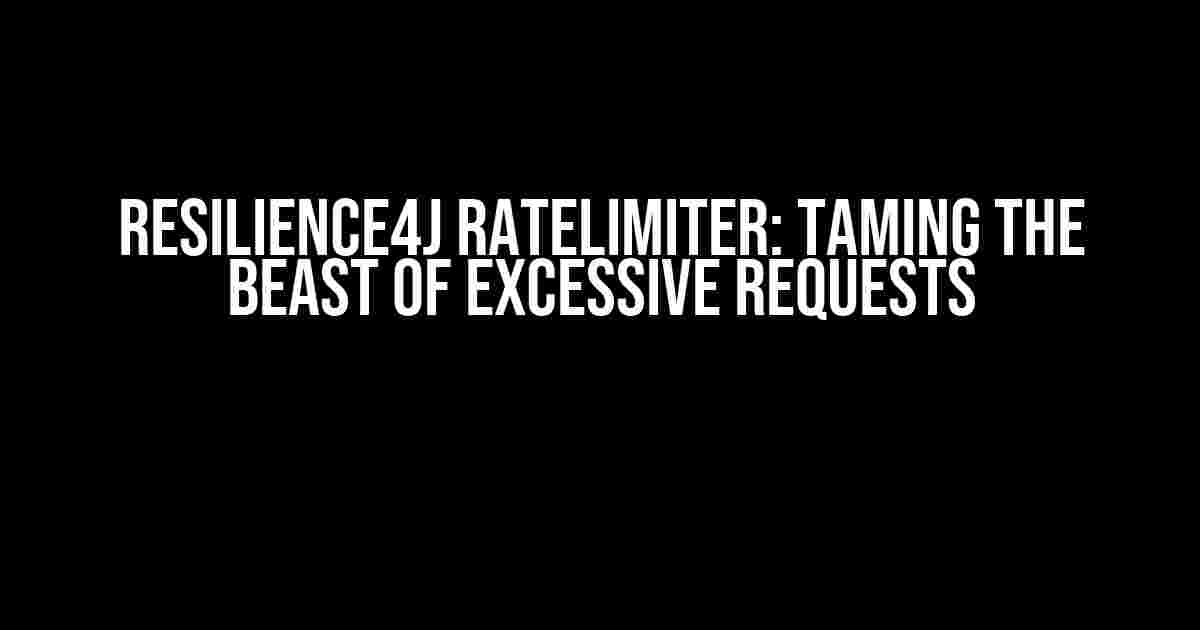Are you tired of dealing with the chaos of excessive requests bombarding your application? Do you find yourself struggling to keep up with the demands of a RateLimiter that’s allowing too many requests in the first period? Fear not, dear developer, for we’ve got you covered! In this article, we’ll delve into the world of Resilience4j RateLimiter and explore the reasons behind this pesky issue. More importantly, we’ll provide you with a step-by-step guide on how to tame this beast and regain control over your request flow.
What is Resilience4j RateLimiter?
Resilience4j is a popular Java library designed to help developers build resilient applications. One of its key features is the RateLimiter, which allows you to limit the number of requests to a specific service or endpoint. The idea is to prevent overwhelm and ensure a smooth user experience. By default, the RateLimiter is configured to allow a certain number of requests within a specified time window.
The Problem: RateLimiter Allowing Too Many Requests in the First Period
So, what’s the issue? You’ve implemented the RateLimiter, but it’s not doing its job as expected. In the first period, the RateLimiter is allowing too many requests, causing your application to buckle under the pressure. This can lead to a range of problems, including:
- Overwhelming your service or endpoint
- Causing performance issues and slowdowns
- Increasing the risk of errors and failures
But why is this happening? There are several reasons why the RateLimiter might be allowing too many requests in the first period:
- Incorrect configuration: You might have misconfigured the RateLimiter, leading to an unintended number of requests being allowed.
- Insufficient warm-up period: The RateLimiter needs a warm-up period to stabilize and adjust to the request flow. If the warm-up period is too short, the RateLimiter might not be able to accurately gauge the request volume.
- High request volume: If the request volume is extremely high, the RateLimiter might struggle to keep up, leading to an excessive number of requests being allowed in the first period.
Solving the Problem: A Step-by-Step Guide
Now that we’ve identified the problem, let’s get down to business and explore the solutions! Follow these steps to tame the Resilience4j RateLimiter and regain control over your request flow:
Step 1: Check Your Configuration
Review your RateLimiter configuration to ensure it’s set up correctly. Pay attention to the following settings:
limitForPeriod: The number of requests allowed within the specified time window.limitRefreshPeriod: The time window in which the requests are counted.warmUpPeriod: The initial period during which the RateLimiter adjusts to the request flow.
RateLimiterConfig config = RateLimiterConfig.custom()
.limitForPeriod(10)
.limitRefreshPeriod(Duration.ofSeconds(1))
.warmUpPeriod(Duration.ofSeconds(30))
.build();
Step 2: Increase the Warm-Up Period
If you suspect that the warm-up period is too short, try increasing it to give the RateLimiter more time to adjust to the request flow. This can help the RateLimiter make more accurate decisions about the number of requests to allow.
RateLimiterConfig config = RateLimiterConfig.custom()
.limitForPeriod(10)
.limitRefreshPeriod(Duration.ofSeconds(1))
.warmUpPeriod(Duration.ofSeconds(60)) // increased warm-up period
.build();
Step 3: Implement a Queue-Based RateLimiter
A queue-based RateLimiter can help mitigate the issue of excessive requests in the first period. This approach involves queuing requests and processing them at a rate that’s within the allowed limit.
QueueBasedRateLimiter queueBasedRateLimiter = new QueueBasedRateLimiter(config);
// Example usage
try {
queueBasedRateLimiter.tryAcquirePermission();
// process the request
} catch (RequestNotPermitted exception) {
// handle the error
}
Step 4: Monitor and Analyze Your Request Flow
It’s essential to monitor and analyze your request flow to identify patterns and trends. This can help you adjust your RateLimiter configuration and fine-tune it for optimal performance.
| Request Count | Time Window | Average Request Rate |
|---|---|---|
| 100 | 1 minute | 1.67 requests/second |
| 500 | 5 minutes | 1.67 requests/second |
| 1000 | 10 minutes | 1.67 requests/second |
Step 5: Consider Alternative RateLimiting Strategies
If the Resilience4j RateLimiter is not meeting your needs, it might be time to explore alternative rate limiting strategies. Some popular alternatives include:
- Leaky Bucket Algorithm
- Token Bucket Algorithm
- Fixed Window Algorithm
Each of these strategies has its strengths and weaknesses, and the choice ultimately depends on your specific use case and requirements.
Conclusion
The Resilience4j RateLimiter is a powerful tool for controlling request flow, but it can be finicky if not configured correctly. By following the steps outlined in this article, you can tame the beast of excessive requests and ensure a smooth user experience for your application. Remember to monitor and analyze your request flow, and be willing to adapt and adjust your RateLimiter configuration as needed. Happy coding!
If you’re still struggling with the Resilience4j RateLimiter, don’t hesitate to reach out to the community for support. And if you have any tips or tricks to share, feel free to leave a comment below!
Frequently Asked Question
Get the scoop on Resilience4j RateLimiter and why it’s allowing too many requests in the first period!
What’s going on with Resilience4j RateLimiter? Is it broken?
Nope, it’s not broken! Resilience4j RateLimiter is designed to allow some burstiness in the first period to prevent unnecessary latency. This means it allows a few extra requests to go through before starting to enforce the specified rate. Don’t worry, it’ll settle down soon!
But I set my rate to 10 requests per minute. Why are 20 requests getting through in the first minute?
That’s because Resilience4j RateLimiter uses a token bucket algorithm, which allows for some burstiness to accommodate sudden spikes in traffic. Think of it like a buffer zone to prevent false positives. You can adjust the burst capacity to control this behavior.
How do I configure Resilience4j RateLimiter to be stricter about rate limiting?
Easy peasy! You can adjust the `rate` and `burstCapacity` properties to fine-tune the rate limiter’s behavior. For example, you can set `burstCapacity` to 1 to immediately start enforcing the rate limit. Just be careful not to set it too low, or you might end up with unnecessary latency.
Will Resilience4j RateLimiter block all requests if I exceed the rate limit?
No way! Resilience4j RateLimiter will simply delay excess requests until the next available slot, ensuring that your system doesn’t get overwhelmed. This way, you can maintain a consistent quality of service while keeping your users happy.
Can I use Resilience4j RateLimiter with other Resilience4j modules?
Absolutely! Resilience4j RateLimiter plays nice with other Resilience4j modules, such as CircuitBreaker and Retry. You can combine them to create a robust and resilient system that can handle all sorts of scenarios.


